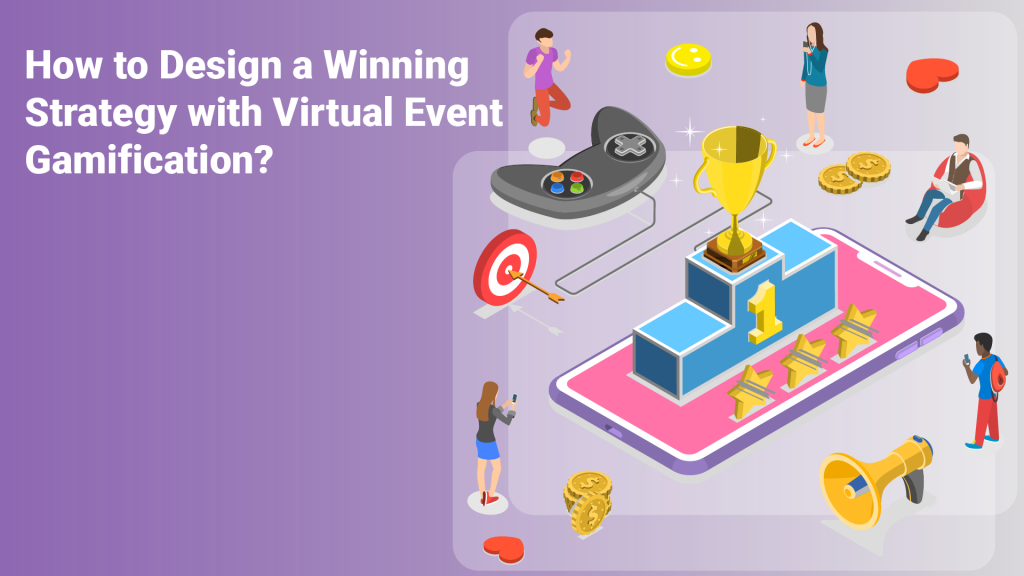
In today’s fast-paced digital world, virtual events have become an increasingly popular way to connect, engage, and educate audiences from around the globe. Event organizers are turning to gamification to elevate the virtual event experience and create an interactive and immersive environment.
Gamification adds an element of fun, competition, and engagement to virtual events, making them more exciting and memorable for participants.
In this blog, we will explore the power of virtual event gamification and provide practical tips and strategies for designing a winning gamification strategy that will captivate your audience, enhance participation, and drive meaningful results.
So, whether you’re planning a conference, trade show, webinar, or any other virtual event, join us as we unlock the secrets to designing a successful gamification strategy that will take your virtual event to the next level!
Why Event Gamification?
Event gamification has rapidly gained popularity as a powerful tool to enhance virtual events for several compelling reasons. First and foremost, gamification injects fun and excitement into virtual events, making them more enjoyable and memorable for participants.
By incorporating game-like features such as challenges, rewards, and leaderboards, virtual events can transform from passive experiences to interactive and engaging ones.
Second, gamification promotes participation and interaction among attendees. It encourages attendees to actively engage with event content, speakers, sponsors, and other participants, leading to increased participation rates, longer attendee dwell times, and higher retention of information.
Gamification also fosters healthy competition, motivating participants to strive for achievements, earn rewards, and climb up leaderboards, which can create a sense of accomplishment and community among attendees.
Creating a Winning Strategy with Virtual Event Gamification
Designing a winning strategy with virtual event gamification involves several key steps. Here are some tips to help you create an effective gamification strategy for your virtual event:
- Define Your Event Goals
Start by clearly identifying your goals and objectives. What are you trying to achieve with your virtual event? Is it increased attendee engagement, networking opportunities, knowledge retention, or lead generation? Understanding your event goals will help you design gamification elements that align with those objectives.
- Know Your Audience
Understand your audience and their preferences. What type of games or activities are likely to resonate with them? Consider their age, interests, and professional backgrounds when selecting gamification elements. Ensure that your chosen games or challenges are enjoyable and relevant to your target audience.
- Choose Relevant Gamification Elements
Select gamification elements that are relevant to your event and participants. This could include leaderboards, quizzes, scavenger hunts, polls, surveys, challenges, or virtual competitions. Choose elements aligned with your event theme and easily integrate them into your virtual event platform.
- Keep it Simple and Intuitive
The gamification elements you choose should be simple, intuitive, and easy to understand. Avoid complex rules or activities that may confuse participants. Keep the gameplay straightforward and accessible to ensure participants can easily engage and participate.
- Offer Meaningful Incentives
Design meaningful incentives that motivate participants to engage with the gamification elements. This could include rewards such as discounts, special access, exclusive content, or virtual badges. Ensure that the incentives are aligned with your event goals and are valuable to your participants to encourage active participation.
- Monitor and Analyze Participant Engagement
Continuously monitor and analyze participant engagement with the gamification elements. Use analytics and data-driven insights to measure the effectiveness of your gamification strategy and make necessary adjustments. Listen to participant feedback and iterate on your gamification elements to optimize engagement.
- Promote and Communicate Gamification Elements
Promote the gamification elements of your virtual event to generate excitement and anticipation among participants. Communicate the rules, incentives, and how to participate in the gamification activities. Use social media, email campaigns, and event promotions to create buzz around your gamified event.
Incorporating gamification into your virtual event can enhance participant engagement, interaction, and enjoyment, ultimately leading to a more successful event. By following these steps and designing a gamification strategy that aligns with your event goals and audience preferences, you can create a winning virtual event experience that stands out and delivers meaningful results.
Super Engaging Event Gamification Ideas
Gamifying an event involves incorporating game-like elements into the experience to make it more engaging, interactive, and enjoyable for participants.
- Scavenger Hunt
Create a virtual scavenger hunt where participants can explore the event platform, visit different virtual booths or sessions, and collect points or badges to find hidden clues or complete challenges. This can encourage participants to actively navigate the platform and interact with event content, speakers, and sponsors.
- Leaderboards and Competitions
Introduce leaderboards and competitions that track participant activities such as session attendance, sponsor engagement, or social media shares. Offer rewards, such as virtual badges, points, or even physical prizes, to participants who earn the most points or achieve specific milestones. This can ignite friendly competition among participants and drive engagement.
- Quizzes and Polls
Incorporate interactive quizzes, polls, or surveys throughout the event to test participants’ knowledge, collect feedback, or gather insights. Offer incentives for participation, such as points or rewards, and display real-time results to create excitement and engagement among participants.
Remember to customize your gamification strategy to align with your event’s goals, audience, and overall theme.
5 Best Gamification Tools
Numerous gamification tools are available in the market, each with unique features and capabilities. Here are five popular gamification tools that can help you enhance your virtual event:
Kahoot! is a popular gamification tool that allows you to create interactive quizzes, surveys, and challenges. It offers a wide range of templates, customization options, and a leaderboard feature to drive competition among participants. Kahoot! can be used for live and on-demand virtual events, making it versatile for various event formats
Wooclap is an interactive platform that enables you to create live polls, quizzes, and surveys for your virtual event. It offers real-time feedback, gamified quizzes with leaderboards, and interactive challenges that can be embedded into your virtual event platform. Wooclap also integrates with popular virtual event platforms like Zoom and Microsoft Teams, making it easy to incorporate gamification into your virtual event.
Duelbox is a gamification platform that allows event organizers to create and host games, challenges, and quizzes to engage attendees. It also includes social media integration, real-time analytics, and customizable branding options.
Scavify is a gamification platform specializing in creating virtual scavenger hunts. You can create custom scavenger hunts with challenges, clues, and points systems, which participants can complete using their smartphones or devices. Scavify offers branding options, real-time analytics, and customizable reward systems, making it ideal for adding an exciting scavenger hunt element to your virtual event.
Bravon is a gamification platform that allows you to create customizable reward and recognition programs for virtual events. You can set up points-based systems, leaderboards, and challenges and offer rewards such as gift cards or discounts to participants. Bravon also provides
6. Quizizz
Quizizz is a gamified quiz platform that allows event organizers to create quizzes and games for attendees to participate in. It includes features like leaderboards, avatars, and power-ups to increase engagement.
TriviaMaker is a gamification platform that allows organizers to create custom trivia games for virtual events. It includes features like music and sound effects, customizable branding options, and real-time analytics.
HuddleXR Community Hub is an attendee engagement solution for virtual events that offers a range of built-in gamification features like leaderboards, challenges, and badges. The platform also allows for the integration of any gamification tool as per event requirements. Attendees can interact with each other in real-time, network, and build lasting connections while participating in custom challenges and quizzes. The platform’s social media sharing, live polls, and survey feature further enhance attendee engagement, making it an ideal choice for event organizers looking to create an immersive experience for their attendees.
Final Words
Incorporating gamification into your virtual event can be a powerful strategy to boost participant engagement, interaction, and enjoyment. By leveraging game-like elements such as leaderboards, quizzes, scavenger hunts, and networking challenges, you can create an immersive and memorable event experience that keeps participants involved and motivated.
When designing a winning strategy with virtual event gamification, it’s essential to consider your event goals, audience preferences, and overall theme. Choose gamification elements that align with your event objectives and create meaningful incentives for your participants.






